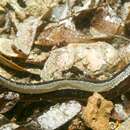Biology
provided by Fishbase
Found in the seagrass areas, commonly amongst blackened dead Amphibolus seagrass leaves in collective areas in Western Port (Ref. 9002).
Comprehensive Description
provided by Smithsonian Contributions to Zoology
Ophiclinus gabrieli Waite
Ophioclinus gabrieli Waite, 1906:208, pl. 36: fig. 7 [lectotype: AMS I.7612, Victoria, Western Port; designated below].
DESCRIPTION.—Cirrus absent on tube of anterior nostril; dorsal fin LII–LV,1; dorsal-fin origin at vertical varying from above posterior ½ of opercle length to just posterior to opercle; predorsal bones 0–1; anal fin II,33–36; anal-fin origin below vertical from base of 18th–20th dorsal-fin spine; interrradial membranes of anal fin not incised; pectoral-fin rays 11 or 12; pectoral-fin length 7.5–8.1 percent SL (in specimens 73.4–86.0 mm SL); caudal fin 2–5 + 13–15 (14 or 15 only rarely in some large specimens) + 2–5; vertebrae 22–23 + 37–40 = 60–62; teeth on vomer uniserial in specimens 72.0–144 mm SL; irregularly biserial in specimens 149–157 mm SL, arranged in a V or U-shaped pattern; cephalic sensory pore positions with single pores, except for ventroanteriormost preopercular canal pore position, which has a pair of pores (position has 1 pore unilaterally in 1 of 26 specimens examined); tube of anterior nostril proximal to dorsal margin of upper lip; hooklike process on cleithrum present or absent.
Lateral Line: Dorsoanterior series of 12–16 pores, connected by diagonal series of pits to posterior midlateral series of pits; pored series originating above vertical at posterior ½–1/3 of opercle length, extending to point below vertical from base of 4th–6th dorsal-fin spine; posterior midlateral series of pits ending on posterior portion of caudal peduncle.
Color Pattern: Head: upper ½–¼ dark brown, nearly black; ventral portions light brown; 2 or 3 dark stripes posterior to orbit; lips and snout may have white mottlings; in one 86.0 mm SL male, dorsal surface pale with darker brown mottlings. Body: upper ½–¼ dark brown, nearly black, lower ½–¾ lighter brown; pale brown area below dorsal-fin base present or absent; posterior portion of body may have white mottlings that extend onto dorsal, anal, and caudal fins (white mottlings conspicuous in specimens 72.0–86.0 mm SL). Dorsal fin: dark brown, or pale and brown mottled; in 86.0 mm male, distal ½ of dorsal fin pale, proximal ½ dark brown. Anal fin: brown, or pale and brown mottled. Pectoral fin: brown with white mottlings, tips of rays pale. Pelvic fin: brown, with darker brown or white mottlings. Caudal fin: brown, with white or darker brown mottlings; tips of rays may be pale.
Males often have darker fins than do females. The line of demarcation between the darker upper parts and the paler lower parts of the head and body is more noticeable in females.
MATERIAL EXAMINED.—N = 26, SL = 72.0.157 mm. SOUTH AUSTRALIA: KANGAROO ISLAND: Stokes Bay, AMS I.20162-026 (2: 123–150), USNM 201468 (2: 144–157); Kingscote, AMS I.20189-035 (149). VICTORIA: WESTERN PORT, AMS I.7611 (2 paralectotypes: 73.4–88.5), AMS I.7612 (lectotype: 92.0). TASMANIA: KELSO, QVML 1972/5/417 (5: 72.0–92.0); DEVON: Greens Beach, USNM 201465 (2: 103–122, including one cleared and stained), QVML 1972/5/399 (8: 97.0–118), USNM 218788 (2: 100), USNM 218789 (86.0).
- bibliographic citation
- George, Anita Mary and Springer, Victor G. 1980. "Revision of the clinid fish tribe Ophiclinini, including five new species, and definition of the family Clinidae." Smithsonian Contributions to Zoology. 1-31. https://doi.org/10.5479/si.00810282.307
Ophiclinus gabrieli: Brief Summary
provided by wikipedia EN
Ophiclinus gabrieli, the Frosted snake-blenny, is a species of clinid native to Amphibolis seagrass in the coastal waters of southern Australia. It can reach a maximum length of 16 centimetres (6.3 in) TL. The specific name honours the Australian pharmacist and conchologist Charles John Gabriel (1879-1963), the collector of the type.
- license
- cc-by-sa-3.0
- copyright
- Wikipedia authors and editors

